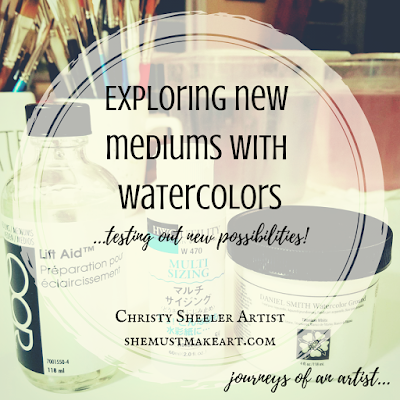 I have new mediums in my stash.
I have new mediums in my stash.
It's like Christmas morning. New art supply order arrives and I am a child again. Excitedly, I search through the package for mediums for my art supply stash. I am in love with exploring new methods and techniques. My mind gets lost in thinking about new watercolor possibilities for future artworks. Sometimes, I need to shake up my artist techniques a little bit. Can you relate? I have three new mediums to share today. I have been testing out how they can work with my watercolor painting process. Here's the scoop on what I've grasped so far!
I had a specific reason for trying out these mediums:
Watercolor paper can lose its sizing.
I have experienced watercolor paper that is no longer its original best which is frustrating. I learned to buy only the paper I need for several months. Great changes in temperature and humidity can affect the sizing. My art room wasn't always heated and so the range of temperatures was hard on my paper. You might still be asking, "what is sizing?" Watercolor papers are treated with a substance like gelatin that makes the surface less absorbent. The watercolor pigment and water can float on the surface. When a paper loses its sizing, the color and pigment sink down quickly and cannot be lifted out. Many times, a strange speckled texture appears in the paper surface.
I want to add that the papers I have had issues with sizing-wise were high quality 140 lb. watercolor papers. This is not about cheaper paper, though it can happen with any quality of watercolor paper.
I want to add that the papers I have had issues with sizing-wise were high quality 140 lb. watercolor papers. This is not about cheaper paper, though it can happen with any quality of watercolor paper.
If you would like to learn more about watercolor sizing: Birgit O'Connor's blog explains this with more detail. If you would like to see examples of what to watch out for: Karen Sioson's blog describes these paper problems along with photos.
I have odds and ends of 140 lb. cold pressed watercolor paper in my paper stash. I would like to be able to treat those papers so I can still paint on them. My search began with wondering if these mediums would be an asset for this purpose.
I have been playing with these three mediums to understand them better.
For each medium, I first want to know...
For each medium, I first want to know...
Question: Will this medium work to help with sizing problems?
---------------------------------------------------------------------------------
Before you begin trying any of these:
1. Set up a work area away from watercolor palette. Don't let any of this mix on your palette.
2. Use a water container that you'll rinse well afterwards. You probably don't want any of this to migrate to your watercolor painting sessions.
3. Rinse your brushes well and right away.
---------------------------------------------------------------------------------
---------------------------------------------------------------------------------
The Mediums I Explored with Watercolors:
QoR Lift Aid 118 ml. $8.74
Holbein Sizing Liquid Medium 60 ml. $12.39
Daniel Smith WC Ground Titanium White 4 oz. $8.19
(Prices at time of order from Cheap Joe's Art Stuff, 2018)
Lift Aid by QoR-------------------------------------------------
I am not sure why I thought this would be a possible solution. I was all out determined to find some options. The QoR lift aid peaked my curiosity. Lifting back to white can be a challenge and I like the idea of having some extra assistance. Don't get me wrong. I am not going to be prepping all my watercolor paper before I begin paintings.
This could be useful in specific situations. If I am preparing to begin a painting of a floral, maybe a wild rose, which has some areas in the center that concern me...then I might apply this in those centers of the rose. This could be an added precaution to help me have less frustration and regret later.
This first photo shows how this did not help with my sizing issue. This is a sheet of watercolor paper that has sizing problems. The lifting aid is not a solution at all. It makes sense that this isn't the purpose of this product. This photo does the best job showing the result of watercolor pigment and water on watercolor paper with compromised sizing. While it's possible to achieve this variety of texture with watercolor, this was not intentional. The watercolor was applied in a way that should have resulted in a smooth wash. This was the result. The result was not caused by the lifting aid.
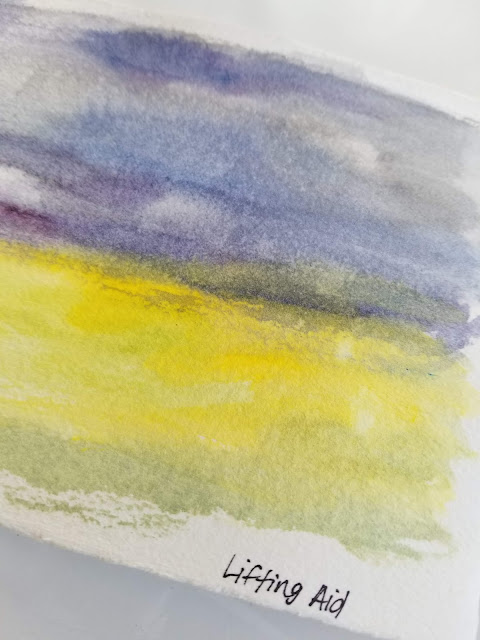 |
| Lift aid on watercolor paper with sizing issues. |
This photo shows testing out on 140 lb. watercolor paper without sizing issues. I marked the right side and that's where I applied the lift aid with a clean damp brush.
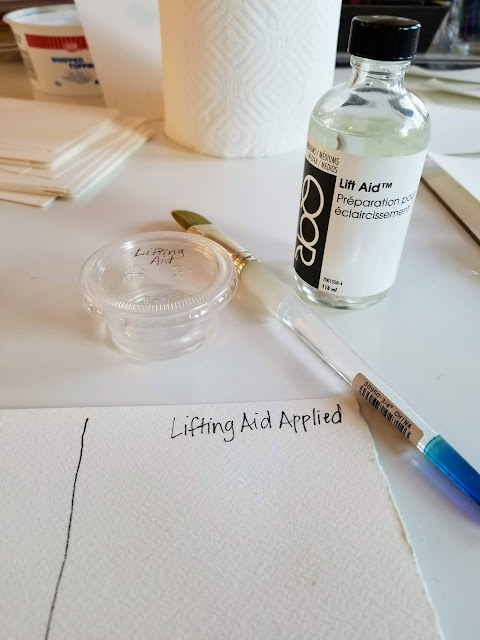 |
| Testing lifting aid on watercolor paper without sizing issues. |
I am impressed by the results. More experimentation is needed. The top area in each side shows where I lifted away pigment with a damp brush. The bottom left shows where I blotted with paper towel. When the paper was dry, I went back in with a damp brush and lifted in the bottom right corner of each section. I used cerulean blue for this test. The amount of pigment in each section does not seem equal, I know. I still feel that considering how much I was able to lift, the results were better in the areas on the right. You might even consider the section on the right made it a bigger challenge for the lifting aid to do well.
Answer: NO for solution to sizing problems. YES to more lifting power.
Answer: NO for solution to sizing problems. YES to more lifting power.
Multi Sizing by Holbein--------------------------------------
I was not sure about proportions for applying the multi sizing. After searching all over the internet, I was able to find some information on the Holbein website, "Artist grade sizing liquid used to reduce the absorbency of paper. Dilute it with warm water and apply it with a broad brush. Available in 60ml squeeze bottle."
A bit of chat on message boards at wetcanvas.com mentions diluting 1 part sizing to 1 part water. I mixed in a separate container this way to make about 1 Tablespoon of multi sizing and water mixture. Once applied with a brush to watercolor paper, I left it to dry for 24 hours or more. The bottle holds 2 oz. and my cost was just under $13. The lift aid can be applied to dry clean paper and between layers of painting. Allow to dry thoroughly each time it is applied.
For my purposes, it's spendy but I am glad to have it in my studio supply for emergencies. Shown here is my test. This is a sheet of watercolor has problems with the sizing gone bad. There is a noticeable line marking where the multi sizing had been applied. This paper was able to handle the application of watercolor like it ought to normally. This DOES solve the issue of watercolor paper being rescued when it would have been unusable for watercolors. It would still be usable otherwise for pencil, ink, chalk, color pencil, pastels...just about anything but watercolor.
Answer: YES for solution to sizing problems. Use 1:1 diluted with water.
A bit of chat on message boards at wetcanvas.com mentions diluting 1 part sizing to 1 part water. I mixed in a separate container this way to make about 1 Tablespoon of multi sizing and water mixture. Once applied with a brush to watercolor paper, I left it to dry for 24 hours or more. The bottle holds 2 oz. and my cost was just under $13. The lift aid can be applied to dry clean paper and between layers of painting. Allow to dry thoroughly each time it is applied.
For my purposes, it's spendy but I am glad to have it in my studio supply for emergencies. Shown here is my test. This is a sheet of watercolor has problems with the sizing gone bad. There is a noticeable line marking where the multi sizing had been applied. This paper was able to handle the application of watercolor like it ought to normally. This DOES solve the issue of watercolor paper being rescued when it would have been unusable for watercolors. It would still be usable otherwise for pencil, ink, chalk, color pencil, pastels...just about anything but watercolor.
Answer: YES for solution to sizing problems. Use 1:1 diluted with water.
 |
| Multi Sizing tested on watercolor paper with sizing issues. |
Watercolor Ground by Daniel Smith------------------------
 |
| Watercolor Ground by Daniel Smith |
The watercolor ground instruction for use was most clear yet very difficult to read (small print on label). The label states, "thick, brushable and heavily pigmented. Allow 24-48 hours to cure before applying Watercolor or Acrylics. Can be thinned up to 10% with water. Wash brushes immediately after use. Do not apply heat to speed drying time."
I have had good results thinning with water before brushing on watercolor paper. The amount you dilute for purposes of use on watercolor paper can be adjusted. This is a good option for watercolor paper that has lost sizing. It is like an opaque white primer. Give close attention to brush strokes if those lines are not desired.
The main purpose for watercolor ground is to make surfaces able to be painted with watercolor. Surfaces like canvas, paper, plaster, hardboard, glass, plastic and metal can be primed with this ground to be the base for a watercolor or acrylic painting once this is applied and left to dry for the appropriate amount of time.
I have begun using this medium to add back whites into watercolor paintings. It's not something I will do often. My goal is always to show the white of the paper.
Answer: YES for solution to sizing problems.
I have had good results thinning with water before brushing on watercolor paper. The amount you dilute for purposes of use on watercolor paper can be adjusted. This is a good option for watercolor paper that has lost sizing. It is like an opaque white primer. Give close attention to brush strokes if those lines are not desired.
The main purpose for watercolor ground is to make surfaces able to be painted with watercolor. Surfaces like canvas, paper, plaster, hardboard, glass, plastic and metal can be primed with this ground to be the base for a watercolor or acrylic painting once this is applied and left to dry for the appropriate amount of time.
I have begun using this medium to add back whites into watercolor paintings. It's not something I will do often. My goal is always to show the white of the paper.
Answer: YES for solution to sizing problems.
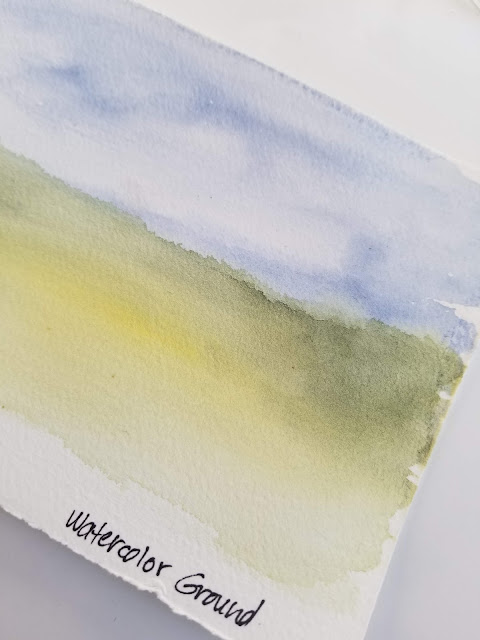 |
| Watercolor ground on watercolor paper with sizing issues. |
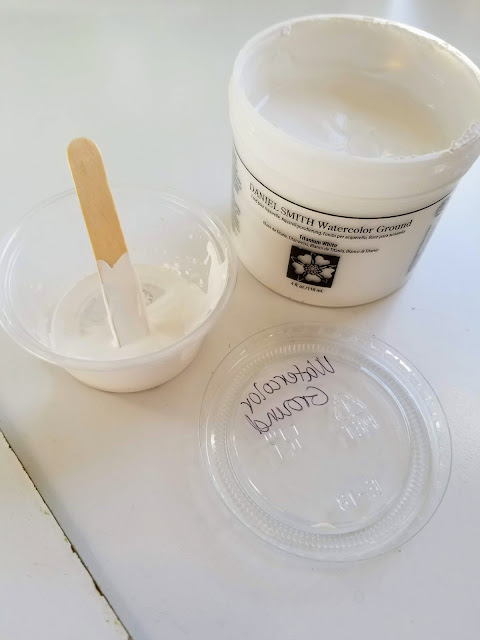 |
| Diluting watercolor ground in a smaller portion. |
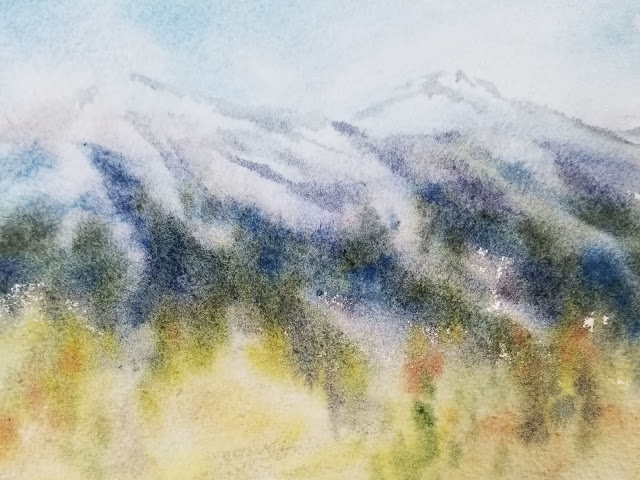 |
| Watercolor painting in progress before applying watercolor ground for whites. |
 |
| Watercolor painting in progress; I add in watercolor ground for whites. |
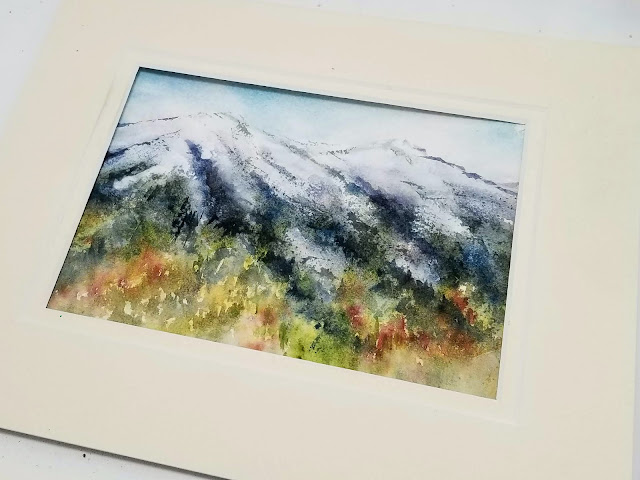 |
| Completed artwork, watercolor ground used to restore more white areas. By Christy Sheeler 2019 |
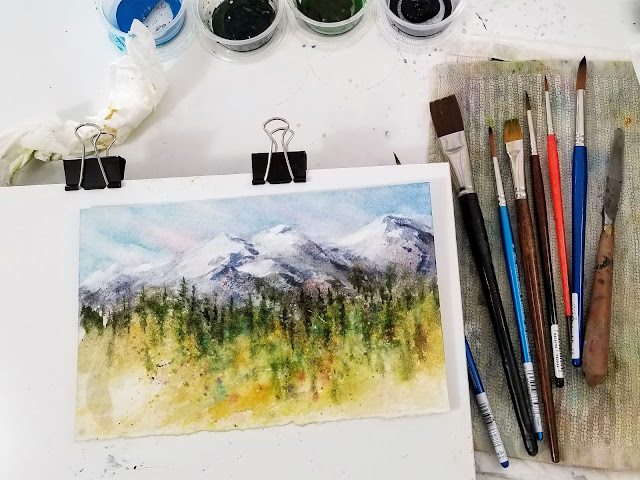 |
| Another watercolor painting in progress; watercolor ground added to bring back whites. By Christy Sheeler 2019 |
My thoughts in reflecting:
For the purpose of addressing my original issue with watercolor paper losing it sizing, here's how I will address it going forward... If I am questioning the sizing, I apply some clean water to a corner of the watercolor paper with a clean brush. I watch how the water and paper interact. If the water sits on the surface, like it's ready to float watercolor pigment, there's good chance it's fine. If the water sinks in fast with no shine, I have a problem to solve.
At this point, I would apply the multi sizing and allow it to dry for at least 24 hours before proceeding with the painting. I would not dilute the multi sizing. Considering the bottle size and cost, this would work best for smaller paintings.
If I begin a painting and find areas of the paper are not reacting to water and pigment correctly, then I would consider the watercolor ground as my solution. In the past, when I had this problem, I diluted gesso and applied it to the paper as a solution. It does work but I am more satisfied with using the watercolor ground.
While I am glad to know how to use the QoR lift aid, I may not use it very often. It will be useful in certain painting situations to safeguard the white or lighter areas of the composition.
If you are trying to decide which to invest in, I recommend the Daniel Smith watercolor ground. It would be my first choice after knowing more about all three mediums. It is a medium with many uses. Now, I am curious about applying it to canvas as a surface for painting with watercolors.
Whew! That was lengthy. If you're still here, we belong to the same artist tribe. My curiosity and hunger to learn more drives me to explore. Let me know if you have any questions.
Christy
She must make art.




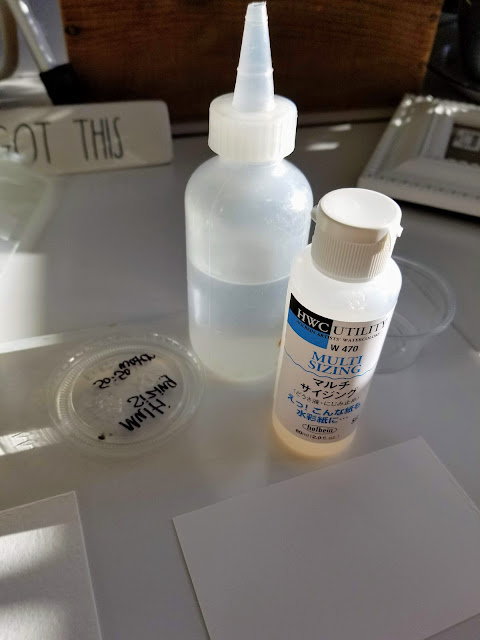
This was really useful. Thank you.
ReplyDeleteSo glad you found it helpful. Thanks for visiting!
DeleteThank you for this!!!
ReplyDeleteThank you for this, answered my exact questions!
ReplyDeleteHi this was awesome but I have a question. I know that any “gesso” formula will most like have a tooth to them. But do any of the others maintain the paper’s original tooth? I am looking to try reducing the absorbency without become rough for markers
ReplyDeleteFor the purpose of use with watercolors, watercolor ground works better than gesso. Are you aiming to use watercolor and markers on the same surface? Qor makes a watercolor ground which I have recently used and it has a much more smooth hot-press-like surface result. Bristol board is another option for markers, having a smooth surface. I have used light washes of watercolor on bristol board and marker would also work nicely on that same surface.
Delete